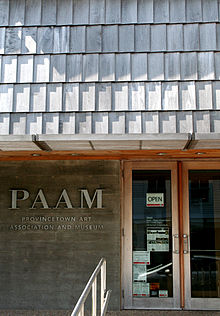Provincetown Art Association and Museum

PAAM entrance
|
|
| Location | Provincetown, Massachusetts |
|---|---|
| Coordinates | 42°03′23″N 70°10′46″W / 42.0564°N 70.1794°WCoordinates: 42°03′23″N 70°10′46″W / 42.0564°N 70.1794°W |
| Type | Art Museum |
| Website | paam.org |
The Provincetown Art Association and Museum (PAAM) is located at 460 Commercial Street in Provincetown, Massachusetts. It is accredited by the American Alliance of Museums and is the most attended art museum on Cape Cod. The museum's permanent collection includes over 2,500 objects, a number which continues to grow through donations and new acquisitions. PAAM mounts approximately forty exhibitions each year,serving as a significant cultural and educational resource for the Provincetown and Cape Cod communities.
The objects and purposes of this association shall be to promote and cultivate the practice and appreciation of all branches of the fine arts, to assemble and maintain in the town of Provincetown and environs a collection of works of art of merit, to hold exhibitions, and by forums, concerts and similar activities to promote education of the public in the arts and social intercourse between artists and laymen. To these ends it shall operate strictly within its charter as a nonprofit, educational, artistic and cultural organization.
Constitution and By-laws Provincetown Art Association and Museum, 1921
Prominent artists Charles Hawthorne, Oscar Gieberich, William Halsall, Gerrit Beneker, E. Ambrose Webster and several local business men and women established the Provincetown Art Association in 1914. The organizing artists donated works and mounted two juried exhibitions in the summer of 1915, beginning a tradition of collecting and exhibiting the work of local artists. By this time, Provincetown had become a refuge of artists and expatriates returned from war-torn Europe. The town was firmly established as "The Biggest Art Colony in the World" (Boston Globe, 8/8/16). PAAM strengthened its role as the anchor of this art colony through the purchase of its present building in 1919. John "Wichita Bill" Noble served as the Association's first director. His son, John A. Noble, also became a prominent artist.
PAAM’s artist founders had come out of the Impressionist tradition and thus did not readily accept the new Modernist movement. Faced with aesthetic differences among its artist membership, however, the organization worked to maintain a balance in the work it exhibited. True to its mission, PAAM mounted separate "Modern" and "Regular" summer exhibitions between 1927 and 1937. Partial conciliation was reached in 1937 when concurrent exhibitions were hung in the same gallery on opposite walls. The rise of Abstract Expressionism—intensified by the location of Hans Hofmann's summer school here—again riffled the deep divisions within the arts community during the '50s.
...
Wikipedia
